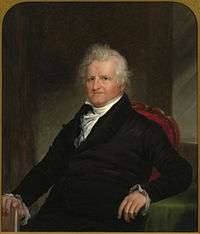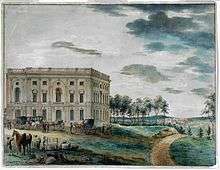11th United States Congress
| 11th United States Congress | |||||||||||||||||||||||||||||
| |||||||||||||||||||||||||||||
The Eleventh United States Congress was a meeting of the legislative branch of the United States federal government, consisting of the United States Senate and the United States House of Representatives. It met in Washington, D.C. from March 4, 1809 to March 4, 1811, during the first two years of James Madison's presidency. The apportionment of seats in the House of Representatives was based on the Second Census of the United States in 1800. Both chambers had a Democratic-Republican majority.
Major events
- March 4, 1809: James Madison became President of the United States
- October 27, 1810: Annexation of West Florida from Spain
Major legislation
- May 1, 1810: Macon's Bill Number 2, ch. 39, 2 Stat. 605
Proposed Constitutional amendments
- May 1, 1810: Titles of Nobility Amendment: Proposed to strip United States citizenship from any citizen who accepted a title of nobility from a foreign country. Although approved by this Congress, it was never ratified by the states.[1]
Party summary
The count below identifies party affiliations at the beginning of the first session of this congress. Changes resulting from subsequent replacements are shown below in the "Changes in membership" section.
Senate
| Party (shading shows control) |
Total | Vacant | ||
|---|---|---|---|---|
| Democratic- Republican (DR) |
Federalist (F) | |||
| End of the previous congress | 28 | 6 | 34 | 0 |
| Begin | 26 | 7 | 33 | 1 |
| End | 8 | 34 | 0 | |
| Final voting share | 76.5% | 23.5% | ||
| Beginning of the next congress | 28 | 6 | 34 | 0 |
House of Representatives
| Party (shading shows control) |
Total | Vacant | ||
|---|---|---|---|---|
| Democratic- Republican (DR) |
Federalist (F) | |||
| End of the previous congress | 115 | 27 | 142 | 0 |
| Begin | 94 | 48 | 142 | 0 |
| End | 47 | 141 | 1 | |
| Final voting share | 66.7% | 33.3% | ||
| Beginning of the next congress | 106 | 36 | 142 | 0 |
Leadership
.jpg)
Senate
- President: George Clinton (DR)
- President pro tempore: John Milledge (DR)
- Andrew Gregg (DR), from June 26, 1809
- John Gaillard (DR), from February 28, 1810
- John Pope (DR), from February 23, 1811
House of Representatives
- Speaker: Joseph B. Varnum (DR)
Members
This list is arranged by chamber, then by state. Senators are listed in order of seniority, and Representatives are listed by district.
Senate
Senators were elected by the state legislatures every two years, with one-third beginning new six-year terms with each Congress. Preceding the names in the list below are Senate class numbers, which indicate the cycle of their election. In this Congress, Class 1 meant their term began with this Congress, requiring re-election in 1814; Class 2 meant their term ended with this Congress, requiring re-election in 1810; and Class 3 meant their term began in the last Congress, requiring re-election in 1812.
Connecticut
Delaware
Georgia
Kentucky
Maryland
Massachusetts
New Hampshire
New Jersey
New York
|
North Carolina
Ohio
Pennsylvania
Rhode Island
South Carolina
Tennessee
Vermont
Virginia
|
House of Representatives

Joseph Bradley Varnum
The names of members of the House of Representatives are preceded by their districts.
Changes in membership
The count below reflects changes from the beginning of the first session of this Congress.
Senate
There were 8 resignations, 2 deaths, 1 interim appointment, and 1 vacancy from before this Congress.
| State (class) |
Vacator | Reason for change | Successor | Date of successor's formal installation |
|---|---|---|---|---|
| Ohio (3) |
Vacant | Edward Tiffin (DR) resigned at the end of the previous Congress. Successor was appointed to continue the term. |
Stanley Griswold (DR) | Seated May 18, 1809 |
| New Jersey (2) |
Aaron Kitchell (DR) | Resigned March 12, 1809. Successor was appointed to continue the term and subsequently elected to finish the term. |
John Condit (DR) | Seated March 21, 1809 |
| Tennessee (2) |
Daniel Smith (DR) | Resigned March 31, 1809. Successor was elected to finish the term. |
Jenkin Whiteside (DR) | Seated April 11, 1809 |
| Rhode Island (1) |
Francis Malbone (F) | Died June 4, 1809. Successor was elected to finish the term. |
Christopher G. Champlin (F) | Seated June 26, 1809 |
| Delaware (1) |
Samuel White (F) | Died November 4, 1809. Successor was appointed to continue the term and subsequently elected to finish the term. |
Outerbridge Horsey (F) | Seated January 12, 1810 |
| Georgia (3) |
John Milledge (DR) | Resigned November 14, 1809. Successor was elected to finish the term. |
Charles Tait (DR) | Seated November 27, 1809 |
| Ohio (3) |
Stanley Griswold (DR) | Appointee was not elected to finish the term. Successor elected December 11, 1809. |
Alexander Campbell (DR) | Seated December 11, 1809 |
| Kentucky (2) |
Buckner Thruston (DR) | Appointed judge of the US District Court of the District of Columbia December 18, 1809 | Henry Clay (DR) | Seated November 4, 1810 |
| New Hampshire (3) |
Nahum Parker (DR) | Resigned June 1, 1810 | Charles Cutts (DR) | Seated June 21, 1810 |
| Connecticut (1) |
James Hillhouse (F) | Resigned June 10, 1810 | Samuel W. Dana (F) | Seated December 4, 1810 |
| Ohio (1) |
Return J. Meigs, Jr. (DR) | Resigned on or before December 10, 1810, to become Governor of Ohio | Thomas Worthington (DR) | Seated December 15, 1810 |
| South Carolina (2) |
Thomas Sumter (DR) | Resigned December 16, 1810 | John Taylor (DR) | Seated December 31, 1810 |
House of Representatives
Of the voting members, there were 12 resignations, 1 death, and 1 change due to a contested election.
| District | Vacator | Reason for change | Successor | Date successor seated |
|---|---|---|---|---|
| Indiana Territory | Vacant | failure to elect | Jonathan Jennings | Seated November 27, 1809 |
| Pennsylvania 1st |
Benjamin Say (DR) | Resigned June, 1809 | Adam Seybert (DR) | Seated October 10, 1809 |
| Massachusetts 7th |
William Baylies (F) | Lost contested election June 28, 1809 | Charles Turner, Jr. (DR) | June 28, 1809 |
| Virginia 21st |
Wilson C. Nicholas (DR) | Resigned November 27, 1809 | David S. Garland (DR) | Seated January 17, 1810 |
| Maryland 7th |
John Brown (DR) | Resigned sometime in 1810 | Robert Wright (DR) | Seated November 29, 1810 |
| Massachusetts 10th |
Jabez Upham (F) | Resigned sometime in 1810 | Joseph Allen (F) | October 8, 1810 |
| New York 2nd |
William Denning (DR) | Resigned sometime in 1810 | Samuel L. Mitchill (DR) | December 4, 1810 |
| Kentucky 5th |
Benjamin Howard (DR) | Resigned April 10, 1810, after becoming Governor of Louisiana Territory | William T. Barry (DR) | Seated August 8, 1810 |
| Connecticut At-large |
Samuel W. Dana (F) | Resigned May 10, 1810, after being elected to US Senate | Ebenezer Huntington (F) | October 11, 1810 |
| Maryland 4th |
Roger Nelson (DR) | Resigned May 14, 1810 | Samuel Ringgold (DR) | Seated October 15, 1810 |
| Massachusetts 11th |
William Stedman (F) | Resigned July 16, 1810 | Abijah Bigelow (F) | October 8, 1810 |
| New Jersey At-large |
James Cox (DR) | Died September 12, 1810 | John A. Scudder (DR) | Seated October 31, 1810 |
| Virginia 1st |
John G. Jackson (DR) | Resigned September 28, 1810 | William McKinley (DR) | Seated December 21, 1810 |
| South Carolina 1st |
Robert Marion (DR) | Resigned October 4, 1810 | Langdon Cheves (DR) | Seated December 31, 1810 |
| South Carolina 4th |
John Taylor (DR) | Resigned December 30, 1810, after becoming US Senator | Vacant | Not filled for remainder of term |
Committees
Lists of committees and their party leaders.
Senate
- Audit and Control the Contingent Expenses of the Senate
- National University
- Whole
House of Representatives
- Accounts
- Arms Exports (Select)
- Claims
- Commerce and Manufactures
- District of Columbia
- Elections
- Post Office and Post Roads
- Public Lands
- Revisal and Unfinished Business
- Rules (Select)
- Standards of Official Conduct
- Ways and Means
- Whole
Joint committees
Employees
Senate
- Chaplain: James J. Wilmer (Episcopalian)
- Obadiah B. Brown (Baptist), from December 5, 1809
- Walter D. Addison (Episcopalian), from December 12, 1810
- Secretary: Samuel A. Otis
- Sergeant at Arms: James Mathers
House of Representatives
- Chaplain: Jesse Lee, Methodist
- Clerk: Patrick Magruder
- Doorkeeper: Thomas Claxton
- Sergeant at Arms: Thomas Dunn
See also
- United States elections, 1808 (elections leading to this Congress)
- United States elections, 1810 (elections during this Congress, leading to the next Congress)
References
- ↑ James J. Kilpatrick, ed. (1961). The Constitution of the United States and Amendments Thereto. Virginia Commission on Constitutional Government. p. 65.
- ↑ Denning never took his seat, and eventually resigned. Apparently he did not send a letter of resignation to the House, but communicated his resignation either to the Governor of New York or the Secretary of State of New York. Almost all old State records were destroyed by a fire which broke out at the New York State Capitol during the United States Senate election in New York, 1911, so that the exact date is possibly no longer to ascertain. Certain is that he resigned in time to have the vacancy filled at the annual State election in late April 1810 when the regular congressional elections were held.
- Martis, Kenneth C. (1989). The Historical Atlas of Political Parties in the United States Congress. New York: Macmillan Publishing Company.
- Martis, Kenneth C. (1982). The Historical Atlas of United States Congressional Districts. New York: Macmillan Publishing Company.
External links
- Statutes at Large, 1789-1875
- Senate Journal, First Forty-three Sessions of Congress
- House Journal, First Forty-three Sessions of Congress
- Biographical Directory of the U.S. Congress
- U.S. House of Representatives: House History
- U.S. Senate: Statistics and Lists
